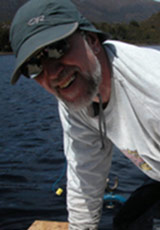Les Cwynar

Academic interests
- Lateglacial climate and vegetation change
- Disturbance ecology: fire and forest moth pest histories
- Ecosystem tipping points
- Beringia
Brief biography
Les C. Cwynar obtained his BSc, MSc and PhD (1980) all from the University of Toronto, yet shows no signs of inbreeding to date. He is a former President of the Canadian Quaternary Association and has served on international committees to define and subdivide the Holocene Epoch, our current interglacial period.
He uses the techniques of pollen, plant macrofossil, charcoal, chironomid, and moth scale analyses to answer questions about treeline history, Beringian paleoecology, and disturbance ecology (fire and forest moth pests), with a foucus on lateglacial environmental change.
Courses taught
- BIOL 2063. Biological Diversity
- BIOL 2068 Laboratory in Biological Diversity
- BIOL 3083 Botany
- BIOL 4351 Climate Change and Environmental Response
- BIOL 4368 Techniques in Paleoecology and Climate Change
Selected research
Milbury, K.J, Cwynar, L.C., and Edwards, S. 2019. Distinguishing eastern North American forest moth pests by wing scale ultrastructure: potential applications in paleoecology. FACETS DOI 10.1139/facets-2018-0051.
Wooller, M.J., Saulnier-Talbot, É., Potter, B.A., Belmecheri, S., Bigelow, N., Choy, K., Cwynar, L.C., Davis, K., Graham, R.W., Kurek, J., Langdon, P., Madeiros, A., Rawcliffe, R., Wang, Y., and Williams, J.W. 2018. A new terrestrial paleoenvironmental record from the Bering Land Bridge and context for human dispersal. Royal Society Open Science. DOI: 10.1098/rsos. 180145.
Rees, A.B.H., Cwynar, L.C. and Fletcher, M-S. 2015. Southern Westerly Winds submit to the ENSO regime: A multiproxy paleohydrology record from Lake Dobson, Tasmania. Quaternary Science Reviews 126: 254-263.
Cwynar, L.C., Rees, A.B.H., Pedersen, C.R., Engels, S. 2012. Depth distribution of chironomids and an evaluation of site-specific and regional lake-depth inference models from the southern Yukon: a good model gone bad? Journal of Paleolimnology 48(3): 517-533.
